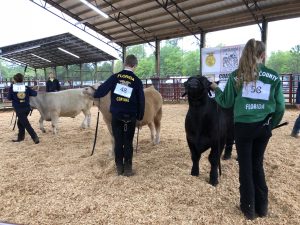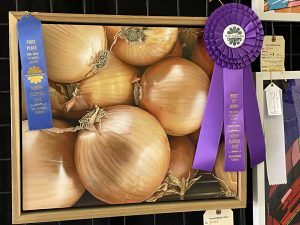The origins of county fairs can be traced back to the late 18th and early 19th centuries. The first recognized county fair was held in 1811 in Berkshire County, Pittsfield, Massachusetts. The Berkshire County Fair exhibited produce, livestock, and other agricultural commodities. Throughout the 19th century, the popularity of county fairs spread across the agricultural communities in America. The fostering of community spirit and camaraderie. County fairs’ economic impact has benefited local communities, with exhibitors traveling into town to showcase their wares. Fairs were about more than rides and funnel cakes initially. It wasn’t until 1893 when George Ferris invented and showcased the Ferris wheel at the Chicago World Fair, that rides became part of fairs. But are fairs really still relevant today?
Fairs are a place where youth can demonstrate the knowledge and skills they have developed through their project work in 4-H. There are three ways youth can do this at a fair: 1. Exhibit non-animal project work, 2. Exhibit an animal they have raised, and 3. participate in a judging contest.
Exhibiting Non-Animal Project Work– Exhibiting what you learned in your project is a culminating experience for 4-Hers. Youth can exhibit plants they have grown, preserved foods, things they have sewn or crafted, or photos or posters about their projects. Adult exhibitors sometimes enter a separate competition by showcasing quilts and baked goods or bringing in their prized roses. As fairs grew, many businesses decided to showcase their new products. Early fairs were the place to find the newfangled washing machine, refrigerator, or even a new tractor!
 Exhibiting Animals– Raising a livestock project can be a valuable source of life lessons and teachable moments, even though many people may not initially consider it as such. A 4-H member is making a serious commitment when they sign up for a livestock project. A commitment to their parents or grandparents who helped purchase the animal. They must be committed to completing the project and the record book. Mostly, that child is seriously committed to the animal they are raising.
Exhibiting Animals– Raising a livestock project can be a valuable source of life lessons and teachable moments, even though many people may not initially consider it as such. A 4-H member is making a serious commitment when they sign up for a livestock project. A commitment to their parents or grandparents who helped purchase the animal. They must be committed to completing the project and the record book. Mostly, that child is seriously committed to the animal they are raising.
Youth can learn much from a livestock project—confidence, responsibility, empathy, goal setting, financial responsibility, and sportsmanship. Livestock projects at county fairs can range from raising a bantam chicken to raising a 1,200-pound steer. Each project can teach youth valuable life skills. In 1952, E.B. White published a book about youth raising livestock for the county fair called “Charlotte’s Web.” In the story, the little girl raises a pig for the county fair, growing up alongside the pig, Wilber. It is highly recommended if you have not read the book or seen either of the movies.
 Competing in Contests– Most fairs offer subject matter specific contests where youth can demonstrate their project knowledge. In the Florida Panhandle, there are contests for Horticulture Judging, Wildlife Ecology, Sewing, Consumer Choices, Science, Technology, Engineering, and Math (STEM), and Agriculture. During these contests, youth use what they have learned to problem solve, communicate, and work as a team. Next time you hear the fair is in town, enjoy the corn dogs and cotton candy, but remember the exhibit hall. You may run into a 4-H club member caring for their animal or watering their plants in the horticulture exhibit.
Competing in Contests– Most fairs offer subject matter specific contests where youth can demonstrate their project knowledge. In the Florida Panhandle, there are contests for Horticulture Judging, Wildlife Ecology, Sewing, Consumer Choices, Science, Technology, Engineering, and Math (STEM), and Agriculture. During these contests, youth use what they have learned to problem solve, communicate, and work as a team. Next time you hear the fair is in town, enjoy the corn dogs and cotton candy, but remember the exhibit hall. You may run into a 4-H club member caring for their animal or watering their plants in the horticulture exhibit.
For more information on 4-H, please contact your local 4-H office. You can find your local office here.
https://nwdistrict.ifas.ufl.edu/4hn/2021/03/04/meet-the-author-prudence-caskey/
Prudence Caskey, Santa Rosa County 4-H Agent II
- Blue Ribbon Scrapbooking and Poetry - October 16, 2024
- The History of County Fairs - July 25, 2024
- 2024 Chick Chain Show Results - May 14, 2024
